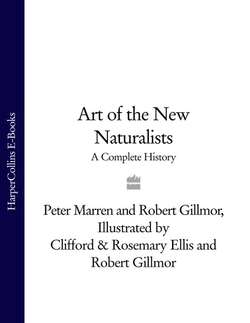Читать книгу Art of the New Naturalists: A Complete History - Peter Marren - Страница 9
‘THE FULFILLED LIFE’
ОглавлениеClifford ran the Bath Academy of Art at Corsham for a quarter of a century, from 1946 until his retirement in 1972, aged 65. He did so with enthusiasm and vigour, and with a syllabus strongly flavoured with Clifford’s inner conviction that ‘arts are the staple of the fulfilled life’. One teacher had been warned before arriving that Clifford ‘had a lot of funny ideas. Corsham was trying to teach too many things all at once … the students were only dabbling in drawing and painting and sculpture’ (Pope). To this, Clifford might have replied that his idea of teaching art was to practise it. He wished to draw from his students the same sense of vocation that he felt himself, ‘like a gardener tending his plants’. He was ahead of his time in believing in teaching by suggestion, by opening windows and encouraging the student to develop their own burgeoning talent.
To further this aim, Clifford resolved to restrict the number of students to a maximum of 250 or so. He also assembled an impressive number of full- and part-time teachers who were, like himself, practising artists, some of whom were, or later became, famous. The distinguished painter William Scott (1913–1989) was the part-time senior painting master, while Kenneth Armitage (1916–2002), who notably made his name with his bronze figures, was in charge of sculpture. The painter-potter James Tower (1919–1988) taught all aspects of pottery and ceramic art, and took students on archaeological digs. A taste of cosmopolitan Europe was brought by the Warsaw-born painter Peter Potworowski (1898–1962). Howard Hodgkin (b. 1932), first a student, taught part-time for eleven years before concentrating full-time on his own painting. At different times, amongst other staff were influential artists like Peter Lanyon (1918–1964), Adrian Heath (1920–1992) and Gillian Ayres (b. 1930). Among such a stellar gathering, the sense one gets from the recollections of Corsham teachers and students is of a bucolic idyll in the Wiltshire countryside among a group of like-minded masters and apprentices.
The surroundings lent themselves to nature study, which was always close to Clifford’s heart. The Court was set in grounds that recalled his beloved boyhood Arundel Park. The academic syllabus included, in the early years at least, botany, biology and geology, and natural forms always remained a key component of pre-diploma and design courses. In keeping with these precepts, Clifford created various gardens at nearby Beechfield, which had also been acquired for the Academy. His ‘bog garden’ lent itself to the first-hand study of various botanical ‘forms’, and there were also aviaries where the students could observe and sketch small birds, pheasants, ducks and geese.
Although they could both put a name to most of the birds and wild flowers they saw, Clifford and Rosemary were more interested in the shapes and designs of nature, with their energy, strength and boundless variety, and the way they feed the artist’s imagination. ‘The artist,’ said Clifford, ‘must develop an acute sympathy for the forms of nature. He is himself part of nature. He is a living organism and its rhythms are his rhythms. Though, as an artist, he will work “parallel to, and not after nature”, he must still refresh himself, and constantly, by a sensitive observation of its forms’ (Ellis, 1945).
Clifford and Rosemary’s book, Modelling for Amateurs, includes not only lively renditions of nature but natural objects themselves: ‘Notice the full roundness of the fox’s skull, and then the sudden ridge that runs down it: or the tough but delicate curve of the deer’s jaw…,’ they wrote. ‘Compare the three shells on the left – see what they have in common and yet how freshly and surprisingly different is each of the individual spirals. Then turn the book sideways and upside down and look at them again. There will be surprises. Then instead of looking at the shells look at the shapes of the background.’
Clifford was remembered at Corsham as a visionary, a man with the confidence to tread his own path and flavour the syllabus with his own artistic credo. Never part of the art establishment, he was seen as a crank in some quarters and never received the national honour many thought he deserved (Brown, 1988). In thanking Clifford and Rosemary for making ‘a seemingly redundant Mansion into a virile Academy of Art’, Lord Methuen felt they had ‘welded Bath to the structure [ie. the house] for another hundred years’ and proved that ‘these historic houses have a future, when used for the benefit of those who come under their influence and who are receptive to their principles of life’ (private letter, 19.7.1972). Alas, long after the Ellises’ departure, changing times finally caught up with the Bath Academy of Art. In 1983, it was amalgamated with the Bath College of Higher Education, and, three years later, lost the unique ambience of Corsham Court. It is now called the Bath School of Art and Design within Bath Spa University. Beechfield, where the students learned to paint and turn their pots, is now a ‘gracious’ housing development, with the house and former stable block converted into flats.
